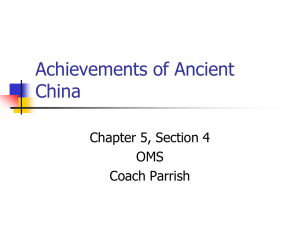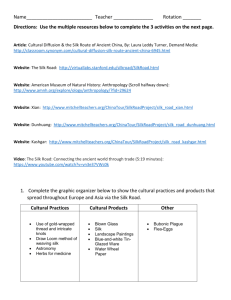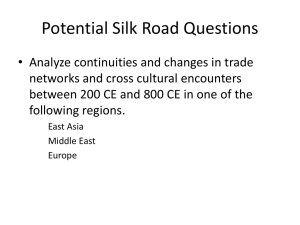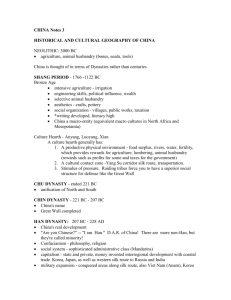The Origin and Development of Sericulture in Korea
advertisement
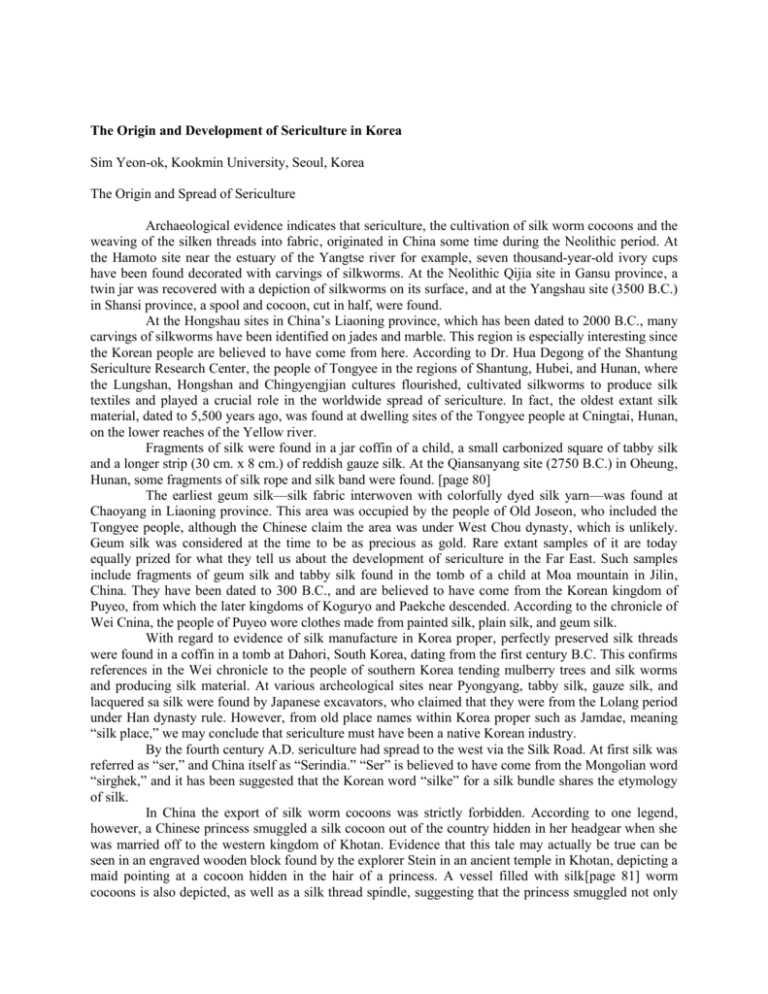
The Origin and Development of Sericulture in Korea Sim Yeon-ok, Kookmin University, Seoul, Korea The Origin and Spread of Sericulture Archaeological evidence indicates that sericulture, the cultivation of silk worm cocoons and the weaving of the silken threads into fabric, originated in China some time during the Neolithic period. At the Hamoto site near the estuary of the Yangtse river for example, seven thousand-year-old ivory cups have been found decorated with carvings of silkworms. At the Neolithic Qijia site in Gansu province, a twin jar was recovered with a depiction of silkworms on its surface, and at the Yangshau site (3500 B.C.) in Shansi province, a spool and cocoon, cut in half, were found. At the Hongshau sites in China’s Liaoning province, which has been dated to 2000 B.C., many carvings of silkworms have been identified on jades and marble. This region is especially interesting since the Korean people are believed to have come from here. According to Dr. Hua Degong of the Shantung Sericulture Research Center, the people of Tongyee in the regions of Shantung, Hubei, and Hunan, where the Lungshan, Hongshan and Chingyengjian cultures flourished, cultivated silkworms to produce silk textiles and played a crucial role in the worldwide spread of sericulture. In fact, the oldest extant silk material, dated to 5,500 years ago, was found at dwelling sites of the Tongyee people at Cningtai, Hunan, on the lower reaches of the Yellow river. Fragments of silk were found in a jar coffin of a child, a small carbonized square of tabby silk and a longer strip (30 cm. x 8 cm.) of reddish gauze silk. At the Qiansanyang site (2750 B.C.) in Oheung, Hunan, some fragments of silk rope and silk band were found. [page 80] The earliest geum silk—silk fabric interwoven with colorfully dyed silk yarn—was found at Chaoyang in Liaoning province. This area was occupied by the people of Old Joseon, who included the Tongyee people, although the Chinese claim the area was under West Chou dynasty, which is unlikely. Geum silk was considered at the time to be as precious as gold. Rare extant samples of it are today equally prized for what they tell us about the development of sericulture in the Far East. Such samples include fragments of geum silk and tabby silk found in the tomb of a child at Moa mountain in Jilin, China. They have been dated to 300 B.C., and are believed to have come from the Korean kingdom of Puyeo, from which the later kingdoms of Koguryo and Paekche descended. According to the chronicle of Wei Cnina, the people of Puyeo wore clothes made from painted silk, plain silk, and geum silk. With regard to evidence of silk manufacture in Korea proper, perfectly preserved silk threads were found in a coffin in a tomb at Dahori, South Korea, dating from the first century B.C. This confirms references in the Wei chronicle to the people of southern Korea tending mulberry trees and silk worms and producing silk material. At various archeological sites near Pyongyang, tabby silk, gauze silk, and lacquered sa silk were found by Japanese excavators, who claimed that they were from the Lolang period under Han dynasty rule. However, from old place names within Korea proper such as Jamdae, meaning “silk place,” we may conclude that sericulture must have been a native Korean industry. By the fourth century A.D. sericulture had spread to the west via the Silk Road. At first silk was referred as “ser,” and China itself as “Serindia.” “Ser” is believed to have come from the Mongolian word “sirghek,” and it has been suggested that the Korean word “silke” for a silk bundle shares the etymology of silk. In China the export of silk worm cocoons was strictly forbidden. According to one legend, however, a Chinese princess smuggled a silk cocoon out of the country hidden in her headgear when she was married off to the western kingdom of Khotan. Evidence that this tale may actually be true can be seen in an engraved wooden block found by the explorer Stein in an ancient temple in Khotan, depicting a maid pointing at a cocoon hidden in the hair of a princess. A vessel filled with silk[page 81] worm cocoons is also depicted, as well as a silk thread spindle, suggesting that the princess smuggled not only silk cocoons out of China, but silk weaving technology as well. In any event knowledge of sericulture eventually was carried further west into the Roman Empire by monks sent to Khotan from Byzantium in the sixth century. Sericulture in the Three Kingdoms Period It was during the Three Kingdoms period that sericulture in Korea really flourished. Various silk textiles such as gyun, si, joo, sa, neung, gi, geum, and ra, as well as colorfully patterned and embroidered silks were produced in both government and private factories. These products and the underlying technology were eventually exported to Japan. In the Koguryo period, ramie and silkworms were raised and sericulture further encouraged, resulting in the development of a variety of products and dying techniques. The Chinese chronicle Hanwon records that such textiles as geum silk and cotton fabric were produced in Koguryo, while the Tang chronicle mentions that ra silk in various colors was used in Koguryo. In the Koguryo murals at Jiban, one can see paintings of geum silk decorated with patterns of the character for “king” (王). Examples of blue and gold colored silk have been recovered in excavations. Another popular color was white, which was especially prized in China, while ikat was exported to Japan. Examples of Koguryo silk are still preserved in the Shosoin treasure house in Japan, including a silk banner embroidered with a beaded medallion pattern. This pattern, which originated in Persia and became fashionable worldwide between the seventh and ninth centuries with the growth in global trade, may be observed in Silla tiles and bricks. In Koguryo, cotton material called baekcheop-po (白疊布) was produced for export to China. This shows that cotton material was pro-duced in Koguryo well before Moon Ik-jeom brought cotton seeds from Vietnam to Goryeo in the fourteenth century. In the Tang chronicle, it is recorded that the king of Paekche wore trousers of blue silk. The Japanese chronicle Nihon Shoki records that silk weaver Juag Anna of Paekche came to Japan and produced kara nisiki at Momohara in Kawachi prefecture, some of which is still preserved. Nihon Shoki also mentions the receipt of a gift from Paekche in [page 82] the fifteenth year of Kinmei’s reign (554 A.D.) of tapdeung, which means “rug” in Persian. By this time Silla craftsmen were skilled at producing rugs and other wool materials. According to Samguk Sagi, the founding king and queen of Silla planted mulberry trees and encouraged sericulture; the resulting silk was used in the king’s own crown. The chronicle also records that Queen Jindeok had silk decorated with poetry woven into the fabric to present to the Tang emperor. Recently fragments of such silk were found in a stupa at Bulguksa temple, and in the Heavenly House tomb. The Goryeo Dynasty During the Goryeo dynasty advances in textile technology were achieved through continuing trade with China. One innovation was the development of gold and silver tinted silk yarns woven into beautiful textiles. From the book “Three City Ode” by Choi Ja, we know that Goryeo aristocrats wrapped the columns of their residences in such rich silks, and laid colored carpets of it upon their floors. At this time textiles were produced not only in government factories, but also in private workshops and Buddhist temples. The government established offices called garment bureaus, where variously titled craftsmen produced high-quality textiles for the royal family and aristocracy, and for trade with foreign countries. Extant samples of fabric from this period, amounting to more than three hundred pieces, have been found in stupas and inside Buddha statues, where they were placed as offerings, providing us with valuable clues not only into Goryeo sericulture technology, but also in fabric preservation. From these recovered pieces we know that Goryeo silk was of the finest quality, and that a wide variety of methods were used in its weaving, dying, embroidery, and decoration. Particularly striking are the weaving methods employed to produce beautiful patterns. With regard to these methods, Goryeo craftsmen are now known to have employed damask, gauge, compound weave, lampas, and weaving with supplementary weft and brocade. The Joseon Dynasty Sericulture was encouraged from the early days of the Joseon dynasty, with the publication of a “Commentary on Sericulture” in the fourth year[page 83] King Sejo’s reign. Although subsequent invasions and upheavals devastated the kingdom and led to a decline in the production of luxury items, silk continued to be manufactured, as evidenced in material recovered from tombs of the period, and in contemporary family treasures that have survived to today. In this period, patterns of Chinese characters were often used, as well as patterns of clouds and flowers. These were designed not solely for their aesthetic appeal, but from Confucian ideals, and a pragmatic wish to encourage good fortune. Wool rugs and carpets were also produced in quantity for export to Japan, where they were used at festivals and in tea ceremonies. The Japanese call them “Joseon tapestries,” and many examples still exist, featuring abstract designs of birds, plants, clouds, and mythical creatures such as may be found in no other country. Other examples depict tigers, magpies, and pine trees, which were favorite themes in folk paintings. In Japan, many of the names used for imported Korean materials included the specific dynasty such as Silla, Goryeo or Joseon, evidence of the long and continuous import of textile materials from Korea. Pattern dyed “chintz” also became popular during the Joseon dynasty. Originating in India, it became fashionable in China and Korea, where it was known as hua-po, and was subsequently transmitted to Japan, along with its manufacturing technology, during the Hideyoshi invasion of 1592— 98, where it is still produced today under the name of sarasa textile. [page 84] [page 85] [page 86] [page 87] Jik-eun neung with flowers, Goryeo dynasty(c.1346), found inside a Buddhist statue at Moonsoo temple [page 88] [page 89] [page 90]



